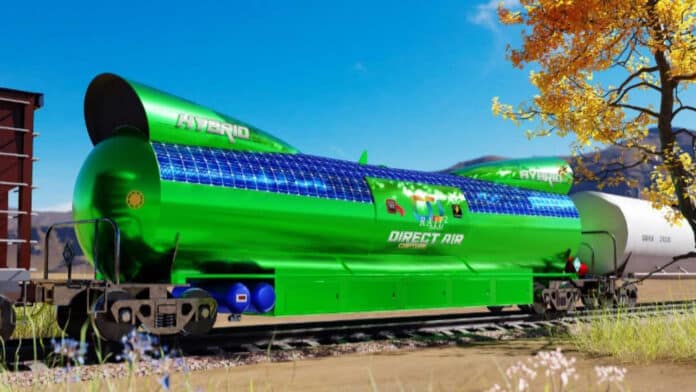The direct capture of carbon dioxide from the environment is increasingly becoming an urgent necessity to mitigate the worst effects of climate change. However, the high energy demands require creative implementation strategies to minimize the diversion of the already-stretched conventional source towards this cause.
The new research shows that rail systems around the world could help mitigate climate change and clean the air of CO2 by capturing the sustainable energy generated when trains brake and decelerate. Engineers from the University of Sheffield are working with the US-based startup, CO2Rail Company, to design Direct Air Capture (DAC) technology that removes carbon dioxide from the air, which can be used within special rail cars placed with already running trains in regular service.
The direct air capture rail cars are designed to capture energy generated through regenerative braking to keep onboard batteries topped up. The CO2Rail cars work by using large intakes of air that extend up into the slipstream of the moving train to move ambient air into the large cylindrical CO2 collection chamber and eliminate the need for energy-intensive fan systems that are necessary with stationary DAC operations.
The air then moves through a chemical process that separates the CO2 from the air, and the carbon dioxide-free air then travels out of the back or underside of the car and returns to the atmosphere. After a sufficient amount has been captured, the chamber is closed, and the harvested CO2 is collected, concentrated, and stored in a liquid reservoir until it can be emptied from the train at a crew change or fuelling stop into normal CO2 rail tank cars. It is then transported into the circular carbon economy as value-added feedstock for CO2 utilization or to nearly geological landfill sites.
According to researchers, each complete train braking maneuver generates enough energy to power 20 homes for an entire day – until now, this enormous amount of sustainable energy has been wasted. If this was captured from nearly every stop made by every train around the world, it would harness 105 times more energy than the Hoover Dam produces in the same time period.
“Currently, the enormous amount of sustainable energy created when a train brake or decelerates is simply lost. This innovative technology will not only use the sustainable energy created by the braking maneuver to harvest significant quantities of CO2, but it will also take advantage of many synergies that integration within the global rail network would provide,” said co-author of the research, Professor Peter Styring, from the University of Sheffield.
Researchers say the technology will harvest meaningful quantities of CO2 at far lower costs and has the conservative potential to reach annual productivity of 0.45 gigatons by 2030, 2.9 gigatons by 2050, and 7.8 gigatons by 2075, with each car having an annual capacity of 3,000 tonnes of CO2 in the near term and more as the technology progresses.
With its sustainable power requirements exclusively supplied by train-generated sources that are without incremental cost, savings of 30-40% per tonne of harvested CO2 can be realized from energy inputs alone. This brings the projected cost at the scale down to less than $50 per tonne and makes the technology not only commercially viable but commercially attractive.
“At these price points and with its tremendous capabilities, CO2Rail is likely to soon become the first megaton-scale, first gigaton-scale, and overall largest provider of direct air capture deployments in the world,” said Professor Geoffrey Ozin from the University of Toronto. The team, which includes researchers from the University of Sheffield, University of Toronto, MIT, Princeton, business, and industry, is also working on a similar system that can remove the CO2 emissions from the exhaust of diesel-powered locomotives as are universally common in North America and other parts of the world.
Direct air capture systems are gaining momentum as a promising approach within the larger carbon emissions removal portfolio. Last month, we saw the construction begin on what will become the world’s largest direct air capture plant that will capture 36,000 tonnes of CO2 per year. Also, Tata Chemicals Europe officially opened the UK’s largest carbon capture plant that will reduce TCE’s carbon emissions by more than 10%.
